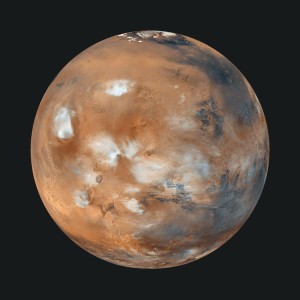Current Events Lesson Plan: December 15-21, 2016
Current Event: The Frozen Waters of Mars
Researchers recently used the Mars Reconnaissance Orbiter (MRO) to discover a vast deposit of ice beneath the surface of Mars. The MRO, launched by the United States National Aeronautics and Space Administration (NASA) in 2005, carries the highest resolution camera ever sent to Mars. Its high-resolution images helped identify safe landing sites for subsequent Mars landers and discovered recurring slope lineae, patterns on Martian hills and valleys likely formed by the flow of liquid water just below ground. Radar on the MRO detected ice in a region called Utopia Planitia. The researchers estimate that the Martian ice deposit holds more water than Lake Superior, the largest body of fresh water on Earth. The deposit is buried beneath as little as 3 feet (1 meter) and as much as 33 feet (10 meters) of Martian soil. The deposit is not solid ice, but rather is 50 to 85 percent ice, with rock, dust, and other materials mixed in. The newly discovered ice deposit may have important implications for the eventual human exploration and colonization of Mars. Other such deposits exist on the planet, but most are small and found in areas with rough terrain. Utopia Planitia is a large, flat basin located in the somewhat warmer mid-latitudes. Therefore, future Mars colonists may be able to land a spacecraft in Utopia Planitia and find water not far from their landing site. Such water could be used for drinking, growing crops, and creating rocket fuel for journeys back to Earth.

Large deposits of ice have been discovered beneath the surface of Mars, the fourth planet from the sun. Credit: NASA/JPL/Malin Space Science Systems
Objective:
Mars is the fourth planet from the sun. Of all the planets in our solar system, Mars has the surface environment that most closely resembles that of Earth. The planet is named for the ancient Roman god of war because its color resembles the color of blood. Mars owes its color to iron-rich minerals in its soil. Today, Mars is nicknamed “the Red Planet” in reference to its color. The planet is much colder than Earth—the average temperature on Mars is about -80 °F (-60 °C). Mars has two tiny moons, Phobos and Deimos, both of which were discovered in 1877. Recently, scientists found strong evidence that water once flowed on the surface of Mars. Mars might once have harbored life, and living things might exist there even today. Although space probes have carried telescopes and other instruments to Mars, no human being has ever set foot on the planet. The Behind the Headlines news story and related World Book articles explore Mars and other astronomical topics.
Words to know:
- Astronomy
- Mars
- Mars Exploration Rover Mission
- Mars Pathfinder
- Mars Science Laboratory
- National Aeronautics and Space Administration (NASA)
- Planet
- Radar
- Space Exploration
Discussion Topics:
1. Ask your students if they can name the seven other planets, besides Mars, in the solar system. (The other planets are Mercury, Venus, Earth, Jupiter, Saturn, Uranus, and Neptune.) See if your student can come up with a mnemonic for remembering the names of the planets.
2. Mars’s two moons were discovered in 1877. Ask your students to name some people who were alive when the moons were discovered. (Students might name Susan B. Anthony, Clara Barton, Alexander Graham Bell, Otto von Bismarck, George Washington Carver, Winston Churchill, Marie Curie, Charles Darwin, Frederick Douglass, Arthur Conan Doyle, Thomas Alva Edison, Sigmund Freud, Geronimo, Ulysses S. Grant, Claude Monet, Florence Nightingale, Alfred Nobel, Theodore Roosevelt, Leo Tolstoy, Harriet Tubman, Mark Twain, Queen Victoria, Booker T. Washington, Woodrow Wilson, Orville and Wilbur Wright.)
3. Private companies have begun launching people into space. Ask your students if they would want to visit Mars. Would they go to Mars if they knew they could never return to Earth?
4. Ask your students to use World Book’s Timelines feature to view or add to the Advances in Space Exploration timeline. (Students may wish to use World Book’s “Space exploration” article for help.)


